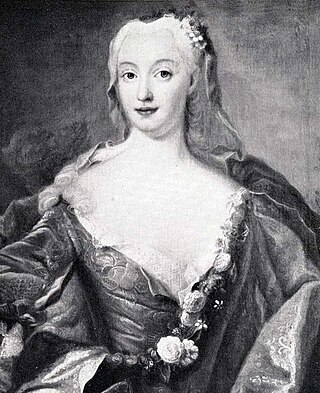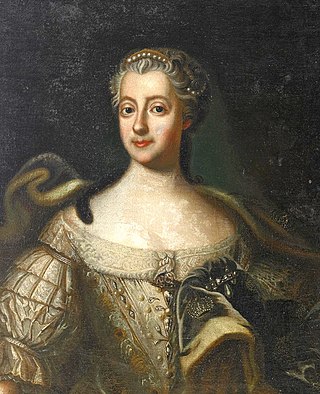| Years in Sweden: | 1753 1754 1755 1756 1757 1758 1759 |
| Centuries: | 17th century · 18th century · 19th century |
| Decades: | 1720s 1730s 1740s 1750s 1760s 1770s 1780s |
| Years: | 1753 1754 1755 1756 1757 1758 1759 |

Events from the year 1756 in Sweden
| Years in Sweden: | 1753 1754 1755 1756 1757 1758 1759 |
| Centuries: | 17th century · 18th century · 19th century |
| Decades: | 1720s 1730s 1740s 1750s 1760s 1770s 1780s |
| Years: | 1753 1754 1755 1756 1757 1758 1759 |

Events from the year 1756 in Sweden

Ulrika Eleonora or Ulrica Eleanor, known as Ulrika Eleonora the Younger, was Queen of Sweden, reigning in her own right from 5 December 1718 until her abdication on 29 February 1720 in favour of her husband King Frederick, and then as his consort until her death.

Hedvig Ulrika Taube, also Countess von Hessenstein was a Swedish courtier and countess, a countess of the Holy Roman Empire, and royal mistress to king Frederick I of Sweden from 1731 to 1744. She is regarded as one of only two official royal mistresses in Swedish history.

Louisa Ulrika of Prussia was Queen of Sweden from 1751 to 1771 as the wife of King Adolf Frederick. She was queen mother during the reign of King Gustav III.

Princess Sophia Albertina of Sweden was the last Princess-Abbess of Quedlinburg Abbey, and as such reigned as vassal monarch of the Holy Roman Empire.

Beata Charlotta "Charlotte" Eckerman, was a Swedish opera singer and actress. She was also a very well known courtesan during the Gustavian era, and the official royal mistress of Charles XIII of Sweden from 1779 to 1781.

Ulrika Eleonora Strömfelt, was a politically active Swedish noble and courtier. She is known for her part in the attempted Coup d'état of queen Louisa Ulrika in 1756.
Henrika Juliana von Liewen was a Swedish noble, socialite and lady-in-waiting, politically active on behalf of the Hats (party) during the Age of liberty.
Ulrika Eleonora von Düben, was a Swedish Courtier, favourite of the queen of Sweden, Louisa Ulrika of Prussia.

Charlotta "Lotta" Fredrika Sparre, commonly named Lotta Sparre, was a Swedish noble and courtier.

Lovisa "Louise" Augusta Meijerfeldtnée Sparre af Sundby, was a Swedish noble and courtier. She is famous in history as one of "the three graces" of the Gustavian age; three ladies-in-waiting immortalized in the poem Gracernas döpelse by Johan Henric Kellgren, and known profiles of the epoch.

L'Ordre de l'Harmonie, also called Solfjädersorden, was a Swedish royal dynastic order, founded by Queen Louisa Ulrika of Sweden in 1744. It was awarded to 22 people between 1744 and 1746.
Hedvig Elisabet Strömfelt, née Wrangel, was a Swedish courtier. She served as överhovmästarinna to two queens of Sweden, Ulrika Eleonora of Sweden and Louisa Ulrika of Prussia, and as Royal Governess to the royal children. Gustav III of Sweden refers to her with affection and admiration in his writings.

Events from the year 1801 in Sweden

Events from the year 1790 in Sweden

Events from the year 1762 in Sweden

The Coup of 1756 was an attempted coup d'état planned by Queen Louisa Ulrika of Sweden to abolish the rule of the Riksdag of the Estates and reinstate absolute monarchy in Sweden. The attempted coup was exposed and subdued in 1756 shortly before it was due to be put in action. It caused a rift between the royal house and the parliament.

Gustaf Jacob Horn af Rantzien (1706–1756) was a Swedish baron. He was executed for treason as one of the conspirators participating in the failed coup d'etat of queen Louisa Ulrika, the Coup of 1756.

December Crisis (1768) was a political crisis which occurred in Sweden in December 1768 when Adolf Frederick, King of Sweden, demonstrated against his limited powers by refusing to sign state documents, thereby paralyzing the government and bringing about a new Riksdag of the Estates.

Marthe de Roucoulle or de Rocoulle (1659–1741) was a French Huguenot educator and salonnaire active in Prussia. She was the governess first of Frederick William I of Prussia and later of his son Frederick the Great.